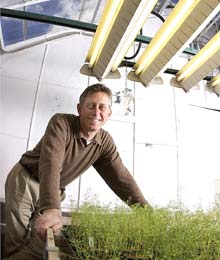More useful plants may sprout from gene role discovery

Clint Chapple
It may be possible to alter plants so they are more nutritious and easier to process without weakening them so much they fall over, according to Purdue University researchers who found a new twist in a plant formation biochemical pathway.
Decreasing the amount of two acids in plant cell walls may enhance livestock feed digestibility for better nutrition, while increasing the potential uses of various plants, said Clint Chapple, Purdue biochemistry professor.
The findings, published in a recent issue of The Plant Cell, revise scientific thinking about the role of ferulic and sinapic acids in building plant cell walls. For many years, researchers believed that the two acids contributed to the production of lignin, the principal structural component of plant cell walls.
“It’s the hardening substance that makes the difference between a piece of celery and a piece of wood,” Chapple said.
Based on laboratory studies, Chapple and his team found that an enzyme converts two molecules into the acids, which then are incorporated into cell walls. This indicates that sinapic and ferulic acids are end products rather than intermediates, or building blocks, in an essential biochemical pathway for cell wall construction, Chapple said.
“Now that we know the acids are not part of the lignin pathway, it may be possible to change cell walls without harming the plant,” he said. “It will be easy to isolate and alter the corresponding gene in other plants, including those used for livestock feed such as corn.”
The main focus of the research is to create more useful plants. In normal plants, cross linking of lignin, ferulic acid and other substances forms a strong bond that make cell walls difficult to break down.
But Chapple said he believes that cell walls could be manipulated so that nutrients in livestock feed are more easily absorbed into the digestive tract.
One clue that led Chapple’s team to its finding came when the scientists looked at leaves from normal and mutant Arabidopsis thaliana plants under ultraviolet lights. The normal Arabidopsis leaves appear blue-green under UV light. Mutants, which lack a derivative of sinapic acid, appeared red under the UV light. This enabled the researchers to identify the gene responsible for synthesis of sinapic and ferulic acids, compounds that subsequently are cross-linked into cell walls.
Altering the gene that programs an enzyme involved in creation of ferulic acid and sinapic acid might be a way to change cell wall make up, Chapple said. His team cloned the gene, called REDUCED EPIDERMAL FLUORESCENCE1 (REF1), which encodes an enzyme that is a member of the aldehyde dehydrogenase family. A similar enzyme helps the human body detoxify alcohol.
“People thought that we’d have a hard time manipulating ferulic acid in corn cell walls because that might mess around with lignin production and the plants would fall over,” Chapple said about earlier hypotheses on producing more digestible animal feed.
The new findings may solve some agriculture production problems, he said.
“We appear to be reaching the limits of productivity in terms of bushels per acre,” Chapple said. “You can only plant things so close together; plants can only grow so big. If a seed company were able to increase yield per acre by 1 percent, that’s a big improvement.”
In contrast, if the quality of a crop or its digestibility could be altered, that would be a significant benefit to farmers and their livestock.
“You could feed a cow more, but even that has a limit because it will only eat so much,” Chapple said. “Or you could make what the cow eats more energy-rich by improving the digestibility.”
The other researchers involved in this study were: Ramesh Nair, now with Pioneer Hi-Bred International; Kristen Bastress, Duke University graduate student; Max Ruegger, now with Dow AgroSciences; and Jeff Denault, Eli Lilly and Co. research scientist. The U.S. Department of Energy’s Division of Energy Biosciences and the Howard Hughes Medical Institute Undergraduate Initiative provided funding for this research.
Writer: Susan A. Steeves, (765) 496-7481, ssteeves@purdue.edu
Source: Clint Chapple, (765) 494-0494, chapple@purdue.edu
Ag Communications: (765) 494-2722; Beth Forbes, bforbes@aes.purdue.edu
Media Contact
All latest news from the category: Agricultural and Forestry Science
Newest articles

Webb captures top of iconic horsehead nebula in unprecedented detail
NASA’s James Webb Space Telescope has captured the sharpest infrared images to date of a zoomed-in portion of one of the most distinctive objects in our skies, the Horsehead Nebula….

Cost-effective, high-capacity, and cyclable lithium-ion battery cathodes
Charge-recharge cycling of lithium-superrich iron oxide, a cost-effective and high-capacity cathode for new-generation lithium-ion batteries, can be greatly improved by doping with readily available mineral elements. The energy capacity and…

Novel genetic plant regeneration approach
…without the application of phytohormones. Researchers develop a novel plant regeneration approach by modulating the expression of genes that control plant cell differentiation. For ages now, plants have been the…





















